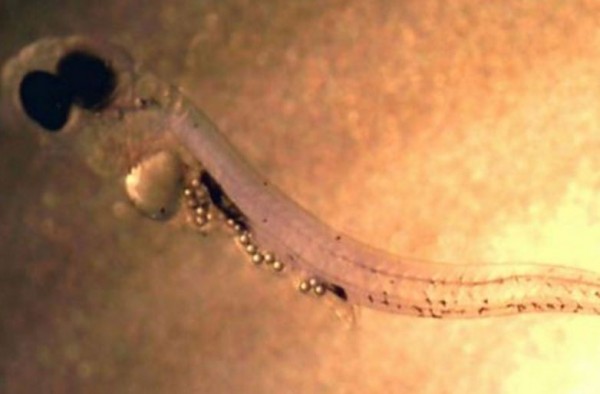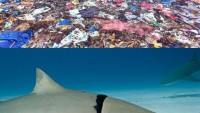Microplastics are Harming Fish Larvae; Becoming a Favorite Food
| Arthur Dominic Villasanta | | Jun 03, 2016 10:34 AM EDT |
(Photo : Uppsala University) Larval perch showing its meal of bead-like microplastic particles
New research has discovered that microplastics, including microbeads, have become a favorite food of fish larvae and are causing harmful mutationsthat threaten them.
This first study to look at the direct effects of microplastic particles on fish development consisted of a series of laboratory experiments with European perch larvae. The results revealed that exposing larvae to microplastic particles similar to levels in the seas suppressed the hatching of fertilized eggs and hindered larval growth. These tiny bits of plastic also made fish more vulnerable to predators.
Like Us on Facebook
Strangely, the study found that some exposed larvae preferred eating polystyrene particles rather than plankton, their natural food. This oddity caused the larvae to grow more slowly and stunted their growth.
The study was conducted by Oona Lönnstedt and Peter Eklöv at Uppsala University. Their study was published in the journal Science.
"Microplastics actually seem to interfere with an animal's natural behaviors, such as feeding choices, activity rates and predator-avoidance strategies," said Lönnstedt. "This is a serious cause for concern, in particular since microplastic particles often accumulate in shallow coastal areas where many developmental stages of aquatic organisms, not just fish, can be found."
"For me, the key finding and biggest surprise in this study was the fact that larvae preferentially ate microplastic particles and literally stuffed themselves with the microbeads," ignoring their natural food source of zooplankton.
Microplastic particles are wee bits of plastic measuring no more than five millimeters. They're the result of the fragmentation of large plastic trash into smaller pieces. They also come from microbeads still used in personal care products such as toothpaste, but which have been banned in the United States.
Lönnstedt and Eklöv also said microplastic pollution harms other fish species. They've conducted similar experiments with other species, both tropical (coral reef damselfish) and temperate (pike and flounder). All showed responses to microplastic particles very similar to the European perch.
"If microplastics are indeed affecting organisms both chemically and physically, then this really calls for a ban on microplastic beads in body-care products and cosmetics around the world," Lönnstedt said.
Tagsmicroplastics, microbeads, European perch, Oona Lönnstedt and Peter Eklöv, Uppsala University
©2015 Chinatopix All rights reserved. Do not reproduce without permission
EDITOR'S PICKS
-

Did the Trump administration just announce plans for a trade war with ‘hostile’ China and Russia?
-

US Senate passes Taiwan travel bill slammed by China
-

As Yan Sihong’s family grieves, here are other Chinese students who went missing abroad. Some have never been found
-

Beijing blasts Western critics who ‘smear China’ with the term sharp power
-

China Envoy Seeks to Defuse Tensions With U.S. as a Trade War Brews
-

Singapore's Deputy PM Provides Bitcoin Vote of Confidence Amid China's Blanket Bans
-

China warns investors over risks in overseas virtual currency trading
-

Chinese government most trustworthy: survey
-

Kashima Antlers On Course For Back-To-Back Titles
MOST POPULAR
LATEST NEWS
Zhou Yongkang: China's Former Security Chief Sentenced to Life in Prison

China's former Chief of the Ministry of Public Security, Zhou Yongkang, has been given a life sentence after he was found guilty of abusing his office, bribery and deliberately ... Full Article
TRENDING STORY

China Pork Prices Expected to Stabilize As The Supplies Recover

Elephone P9000 Smartphone is now on Sale on Amazon India

There's a Big Chance Cliffhangers Won't Still Be Resolved When Grey's Anatomy Season 13 Returns

Supreme Court Ruled on Samsung vs Apple Dispute for Patent Infringement

Microsoft Surface Pro 5 Rumors and Release Date: What is the Latest?













